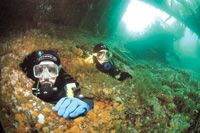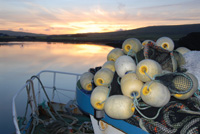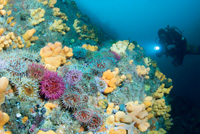- Details
- Written by: David
So let’s look at those options. If you happen to live in one of the big cities – Edinburgh or Glasgow – you have close access to the great Firths: those broad, tidal rivers that are home to dozens of wrecks. Stretching between the Isle of Arran and the west coast mainland is the Firth of Clyde, a name synonymous with the shipping industry. These waters, while lacking the clarity found further north, do have an impressive array of shipwrecks, including a popular training wreck, the Catalina; and, for more advanced divers, the steamer Kintyre, with its beds of plumose anemones.
The story is similar on the east coast, where the Firth of Forth offers average visibility of around 3m, but with the convenience of being situated around the capital city, Edinburgh. Again, wrecks are the main attraction: the aircraft carrier HMS Campania provide a huge area of tangled metal covered in invertebrates, while older wrecks can be found off Burntisland on the Fife coast. Those in search of scenic reefs should head to Blae Rock or the imposing hulk of Bass Rock.
Probably the most famous diving on the east coast is found around the fishing villages of St Abbs and Eyemouth. With consistently clear water, dramatic underwater topography and a smattering of wrecks, the place could have been designed for divers. Much of the credit for its thriving environment should go to underwater photographer Lawson Wood, who helped to establish the area as Britain’s first voluntary marine reserve.
While there are shipwrecks at diveable depth all over the Scottish coast, there’s nowhere to compare with Scapa Flow, a natural harbour in the Orkney Islands. This was the scene in 1918 of the scuttling of the German High Seas Fleet on the orders of its own admiral. Many of the wrecks were salvaged, but several were too deep, and so there remains a selection of light cruisers, battleships and other vessels, all in relatively clear water.
 Combine this with the shallow blockships sunk to protect the entrances to the Flow, plus several incidental wrecks, and you have the best wreck-diving area in the northern hemisphere. There’s enough here to satisfy the most advanced divers in Britain, but equally you could come here with 20 or 30 dives under your belt and have a fine time diving the light cruisers and the blockships. Liveaboard and day diving are both available out of Stromness.
Combine this with the shallow blockships sunk to protect the entrances to the Flow, plus several incidental wrecks, and you have the best wreck-diving area in the northern hemisphere. There’s enough here to satisfy the most advanced divers in Britain, but equally you could come here with 20 or 30 dives under your belt and have a fine time diving the light cruisers and the blockships. Liveaboard and day diving are both available out of Stromness.
North of Orkney lie the Shetland Islands, bleak and remote, but with efficient sea and air links and some truly great diving. Here you will find the best visibility in the UK, with summer averages of around 20m. While Shetland may not have Scapa’s concentration of wrecks, it combines the very best of UK diving – seals, reefs, wrecks, fish, caves – all in beautiful blue water. Several Scapa liveaboards come here in the summer, and the local BSAC club can accommodate guests by arrangement.
Heading back to the mainland, the sites on the bleak north coast of Scotland are more weather-dependent, and most of the diving is carried out by local clubs rather than visitors. When conditions are favourable, the diving here can be outstanding – highlights including the wreck of HMS Vulture in Loch Eriboll, exciting drifts at Cape Wrath and, down the west coast, spectacular walls at Kinlochbervie.
Further south, there’s a rich marine scene around the Summer Isles, including the wreck of the Fairweather V close to Ullapool. But the real draw for divers along the west coast is the port of Oban. Long established as a club favourite and set against the beautiful hills of Argyll, Oban is the gateway to the Hebrides, and a fine base to dive the Sound of Mull, famous for its shipwrecks.
Several liveaboards operate out of Oban, offering access to the mosaic of islands that lie offshore. From the sinister mountains of Skye to the craggy isolation of Lewis, the diving opportunities are innumerable, and great sites are being discovered all the time. Of the established favourites, the wall dive at Canna island is widely held to be the most beautiful in Britain, but there are many close contenders all around.
And, of course, there’s St Kilda, an abandoned island bastion lying 60 miles beyond the Outer Hebrides. Fed by oceanic currents, this little archipelago of towering cliffs is a haven for marine life to rank alongside the best in the world. This is expedition diving at its wildest, and the islands can be subject to cruel Atlantic swells, but for divers with experience, a trip to St Kilda is something to aspire to.
Top Dives
The Hispania, Sound of Mull Sitting upright and fed by the nutrients, the bow of this wreck is covered in yellow and orange anemones.
Cathedral Rock, St Abbs An iconic dive that offers countless opportunities for fish spotting, alongside the majesty of the submerged arch.
Out Stack, Shetland You’ll find this hidden gulley just beyond Britain’s most northerly speck of land. Pulsing with fish and adorned with multi-coloured anemones, it is a standard-bearer for British diving.
 While on Land
While on Land
• Enjoy a pint in the Oban Inn, a famous divers’ haunt
• Visit Lyness Interpretation Centre in Hoy, a museum that tells the story of the Royal Navy at Scapa flow through the two world wars
• Stroll along the beautiful harbour at Tobermory in Mull, then enjoy a dram
of single malt in the Mishnish Hotel
• Enjoy award-winning fish and chips at the Anstruther Fish Bar on the Firth of Forth
• Watch otters hunting for blennies and sand eels in Shetland
• Driving up through the Borders towards Edinburgh? Take a stop at pretty Melrose and explore the ruins of a Cistercian monastery

 DIVE Britain...
DIVE Britain...

